
Cannabis Developers Threaten Affordable Housing
by Rebecca Firestone with Mark English AIA | Editorials
“How would buildings full of plants and a few caretakers help to create a lively urban context? People not plants!”
– Mark English, AIA
In Oakland this past December, a new drama was unfolding with major implications for the area, and for economic development. At stake was The Oakland Cannery, one of the oldest legal live/work artist buildings in the Bay Area, sold last November to a “cannabis real estate investment company” named Green Sage, with three partners based in Denver and Beverly Hills.
They’d privately proclaimed grand intentions to gut the building in a “state-of-the-art renovation” that would, incidentally, displace a bunch of artists, one of whom had lived there since the late 1970s. With an acute housing shortage driving rents out of reach, an increasing number of artists and even middle-class people were leaving the Bay Area altogether. (Full disclosure: this is my building, and my story too.)
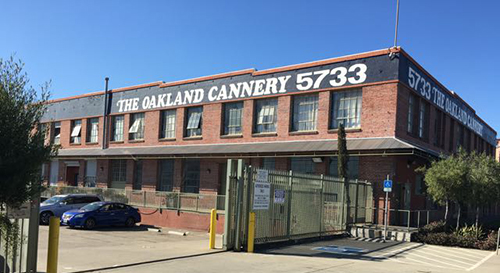
The Oakland Cannery is unusual in that it’s a mixed-use commercial and residential building. Image: Rebecca Firestone
“We Built This Place”
“We built this place,” said Arthur Monroe, an Abstract Expressionist artist and long-time Cannery resident who’d been living and teaching in the Bay Area for 40 years. “We put in plumbing and electricity ourselves.” The City of Oakland originally tried to kick them out, because people weren’t allowed to live in industrial buildings. Eventually the artists negotiated a deal and stayed on, through a few changes in ownership and gradual upgrades, until the building was brought fully up to code in around 2010.
But the new owners didn’t care about all this sweat equity. All they saw was a free-market opportunity. The Green Sage partners had bought up the Cannery building along with 3 others on the same strip of land, with the intention to market it to cannabis investors and businesses. The residential tenants only found out about the sale when one of the residents’ power went out. Turns out the sale had happened the week before, on November 22, 2017.
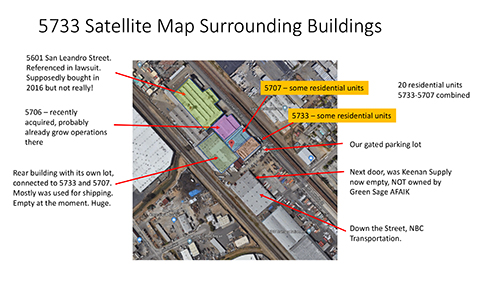
Cannabis real estate investors grabbed all the buildings on this Oakland city block. Two of these buildings have residential units in them, which are threatened. Image: Rebecca Firestone
Apart from a letter with instructions on where to sent rent payment, there was no communication with the tenants. Rebecca Firestone, another resident (and the writer of this article) met the owners by chance the same day tenants learned of the sale. One of them confirmed that they intended to repurpose the building and convert it to a state-of-the-art cannabis facility. So no, residents wouldn’t be allowed to stay.
There weren’t a lot of other options for re-homing – something wealthy out-of-towners might not be aware of. If the Cannery tenants wanted to remain in the area, they would have to fight to keep their existing homes.
The Oakland Cannery Collective
The new owners soon ran up against a well-organized tenant opposition. Arthur’s son Alistair Monroe had media contacts and grass-roots organizing experience, including founding the North Beach Jazz Festival. For the first time, all the neighbors got together and started trading information. The talent pool included legal research, media, visual art, fundraising, and writing. Within 2 weeks there was a mission statement and a web site, and an interview on KPIX lined up.
The Green Sage web site proclaims that their mission includes “helping to set the standard for transparency, integrity & accountability in the Cannabis Industry”. However, when the KPIX correspondent called them, they hung up saying “No comment.”
Doing the Homework
Rebecca looked up the deeds of sale down at the Records Office. Apparently the building was not only legally zoned for residential, but was also under rent control, having been occupied prior to 1983. She had a preliminary meeting with a tenants’ rights attorney to find out what could actually happen and what the options might be. “Better to know for sure than sit around wringing our hands in the dark.”
The most likely legal vehicle, and the only one available since Oakland has protections against no-fault evictions, would be an Ellis Act eviction. This statewide California law allows a landlord to go out of the rental business. The kicker is that once the dwelling units are off the market, they can’t be revived for 10 years, even if the building is subsequently sold.
It was uncertain if and when anyone would receive notices: first it was going to be December, then January. Meantime, the original KPIX interview story aired repeatedly for several weeks.
At that time, Green Sage refused to comment to the press.
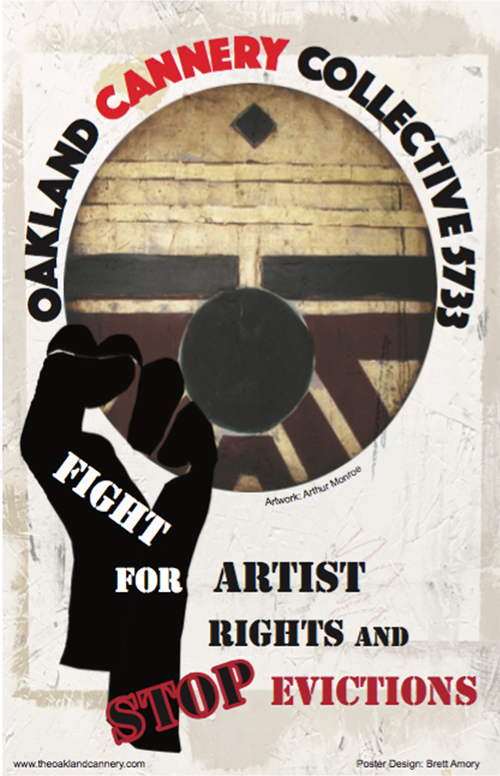
The Cannery artists collaborated on a flyer that was distributed at City Hall Council chambers during a recent hearing. Image: Brett Amory, Arthur Monroe
Legislative Remedies
After the KPIX story aired, it was the time to go after lawmakers. Tenants met with State Senator Nancy Skinner as well as local Oakland City Councilmembers Noel Gallo and Rebecca Kaplan, all of whom were already deeply concerned about housing shortages and displacement. The message was fortuitous, and resonated in what was already an acute crisis, with tent cities under freeways. Pro-housing groups saw homeowners concerned about their neighborhoods losing the diversity that was, for many, the lifeblood of the city.
The Cannery tenants got themselves on the agenda for Oakland’s Cannabis Regulatory Commission. Eventually, they caught the ear of Oakland Mayor Libby Schaaf and her policy liaison for the arts, Kelley Kahn. Schaaf herself has a background both in arts advocacy and a law degree; Kahn is a city planner by training.
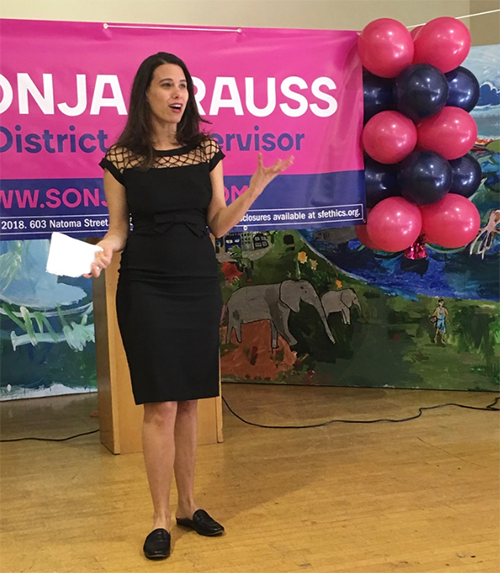
Pro-housing political candidate Sonja Trauss put the Cannery residents in touch with East Bay advocacy groups such as East Bay for Everyone. Trauss is currently running for SF Supervisor.
“It was a crash course in civics,” said Rebecca. “I actually have renewed faith in our local lawmakers. They’re accountable and competent, not crazy like our national legislature seems to be.” Rebecca reached out to housing advocacy groups such as Sonja Trauss, YIMBY , East Bay for Everyone , the Oakland Warehouse Coalition, and the Oakland Tenants Union. It seemed like allies and advocates sprang up out of the woodwork at every turn. The Cannery tenants learned how Council hearings worked, and how to speak their piece in 2 minutes with a timer.
Conflicting Policies
As everyone at City Hall worked feverishly to frame the problem, it became apparent that the most shareable viewpoint was one of inadvertent policy collisions that could be remedied through changes to City policy. Statewide, the governing law was the Ellis Act, which allows property owners to get out of the landlord business by removing residential units from the marketplace – permanently.
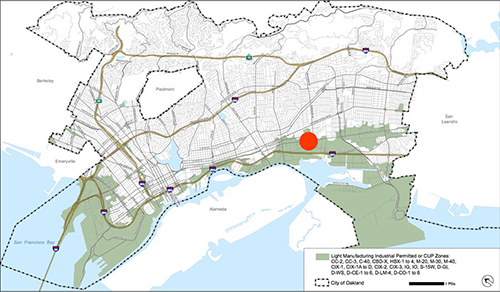
Oakland’s Green Zone allows for cannabis cultivation and manufacture. The red dot shows the location of The Oakland Cannery building. Image: East Bay Express
On one side, Oakland had created a carefully crafted cannabis development policy allowing legal cultivation in a designated “Green Zone” that is mostly light industrial already. On the other, Oakland had embraced initiatives to keep its existing artist communities from being priced out of the area – along with many other moderate-income and even middle-class residents.
Housing Crisis is Far-Reaching
The housing crisis has gotten so bad that even the state legislature is getting involved. It’s way bigger than artists. Of the country’s homeless, 25% of them live in California. And while some homeless people are difficult to help, others are people who are one medical crisis or lost work shift away from evictions. And once they lose their apartment, there aren’t affordable alternatives. That is exactly the same problem faced by the Cannery artists as well.
In fact, many live/works are facing a parallel crisis: their buildings, or the land that they’re on, are being sold to developers who want to create market-rate housing, condos or pricey rentals. New owners typically have no obligation to re-home or protect the former tenants from displacement. One example here is Vulcan Studios, as of this writing being put out for bids. This is “gentrification” at its worst.
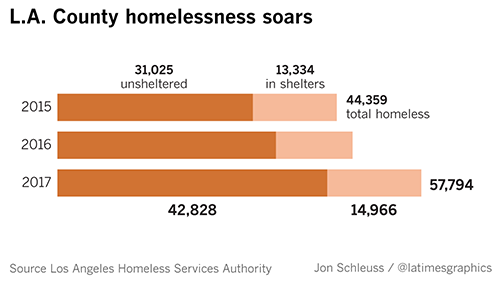
In Los Angeles, the homeless population jumped 30% in 2 years. Image: LA Times and Los Angeles Homeless Services Authority
“All the artists left San Francisco and moved to Oakland,” said Brett Amory, another Cannery artist. “And now they’re being forced out of Oakland, too.”
Keep Oakland Local
Another aspect of the story is that the Green Sage partners are out-of-towners with no connection to the area, and (until recently) no finger on the pulse. Pro-housing advocate Sonja Trauss has been quick to say that whether developers are greedy is irrelevant – but in this case, the developers would be removing housing rather than adding it, when they could choose a plan that would allow residents to remain.

Cannabis is taxed at 30%, although prices may not stay high – something investors might consider before dreaming of sky-high profits
Cliffhanger at City Hall
A City-wide policy change offered the best chance of success – and coexistence. Councilmember Rebecca Kaplan drafted some initial recommendations and presented them to the Oakland Cannabis Regulatory Commission – at a public hearing which Green Sage did not attend, perhaps because they weren’t paying attention.

Oakland City Councilmember-at-large Rebecca Kaplan made some practical recommendations for preventing cannabis-related displacement of artists.
Then Oakland Mayor Libby Schaaf, together with various other Oakland City Councilmembers, agreed to convene an emergency session with legislation jointly sponsored by Councilmember Rebecca Kaplan, the Office of the Mayor, and the Office of the City Administrator. The City Attorney’s office worked around the clock to craft amendments to Oakland’s existing cannabis laws, in a way that would allow both live/works and cannabis to peacefully co-exist.

Excerpt from the legislation and staff report for co-sponsored Oakland Mayor Libby Schaaf and Oakland City Councilmember-at-large Rebecca Kaplan. It would restrict cannabis operating licenses if those operations occurred on premises that previously saw residential uses.
The Council meeting itself had relatively few surprises. Green Sage did not attend. Several local cannabis groups spoke up on behalf of the tenant protections, including one cannabis business already operating in the building. This is as much about small local businesses priced out by large out-of-town enterprises as it is about residential displacement. Several people suggested that grow operations should occur in greenhouses to save energy – yeah, why not?
“The changes before you today will help protect the small businesses, makers and artists that depend on these living and working spaces for their livelihoods.”
– Office of the Mayor, statement
The proposed legislation was unanimously approved, and subsequently passed into law on March 20, 2018. That’s not the end of the battle, here, of course – the next question is whether it will motivate Green Sage towards a substantial good-faith negotiation with the Cannery artists.
“We want to establish a mutually beneficial solution,” said Rebecca.
And, there is actually some real hope of this happening. Other artists have bought their own buildings, through nonprofits and land trusts and a lot of determination. Or, at the very least, stepping up to the table and accepting shared responsibility for the building operating costs, so that the owners have a positive incentive to collaborate.
Do Artists Add Value?
Two arguments put forth address different needs: first, affordable housing for everyone, and also the special value that artists bring to a city.
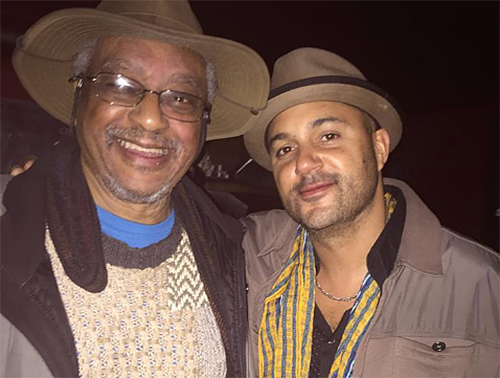
Oakland artist Arthur Monroe and his son Alistair. Do artists add value to a city? Millions of people visit New York and Paris for their arts and culture – so, yes.
Fred Hertz, a local attorney with 30 years’ experience representing artists, remarked “The politics of the city have been that artists are not ‘deserving’ poor — unlike other low income people. There are many things the city could do (and most other cities do in fact), such as protective zoning, using city lots for artist housing, waive fees and city taxes for property owners who rent to artists.”
One way creative types can add value is by making their city a culture magnet. “Paris is the most-visited city in the world,” said Eddie Colla, an artist who’s lived in the Cannery for 25 years. “It’s because of their long-standing commitment to the arts.” It’s true: all of Oakland’s live music venues, dance theaters, art galleries, poetry slams, “maker” events, are presented by people who spend a good portion of their time honing their craft – and who aren’t making six figures. Many technology innovators start out poor, too. Heck, even highbrow orchestra musicians don’t make all that much.
In fact, the City of Oakland is drafting up an ambitious new cultural preservation plan, which mentions economics, maps existing cultural assets (live/works, art galleries, performance spaces, dance and yoga studios, music venues, and more), and seeks to preserve local spaces, including those for specific demographics.
Equity as a Planning Concept
In the course of all this, I discovered a new word: equity. In the new language of 21st century social-justice urbanism, equity is an approach to remedying long-term structural inequalities, sot that people who’ve lived in an area but have been dispossessed all along, can share in prosperity gains from new development. Sometimes referred to as social equity, it is often tied to outcomes for various aspects of living: economic opportunity, safety, health, education, employment, transportation.

The City of Oakland has created a Cultural Assets map that includes art, movement, music, bookstores, theaters, nightlife, educational spaces, and other landmarks.
Oakland’s artists are only one of many groups seeking greater equity in the urban planning process. Is it even possible to have development without displacement? We certainly hope so, even if past models of “urban cleansing” led to whites-only suburbs and segregated ghettos.
High-Risk Industry
It’s interesting comparing the cannabis industry in the U.S. with these 6 “cannabis moguls” in Canada. Despite widespread state-level legalization, cannabis in the U.S. remains a quasi-legal, cash-based business. It’s hard to find banks, lines of credit, or capital. Companies with U.S. operations can’t be listed on U.S. stock markets. Product can’t be transported across state lines. Dispensaries can’t take credit cards as payment.
As a source of development capital, cannabis is a high-risk investment. The industry has already seen large price drops and fluctuations: 10% in one week alone. This “race to the bottom” could lead to large-scale industry consolidations over the next few years.

Real estate speculation is the urban equivalent of strip-mining: it clears away existing residential communities and ultimately increases urban blight.
Once a building has been Ellis Acted, those residential units remain lost for 10 years. The communities are lost as well, to be replaced by… what? If the owners go bankrupt, it’ll be empty buildings, trash, and un-regulated activity. Financial arguments that justify any and all behaviors are disingenuous. Capitalists can be good citizens while still making a profit.
“We’re not against cannabis,” said Rebecca at a recent Oakland City Hall committee hearing. “But profits should not REQUIRE displacement.”
Local Cannabis Culture is Different
Even within the cannabis industry, there’s a lot of concern with supporting local businesses, local non-profits that deliver medical cannabis to high-needs populations. Coming up with a business and policy model that allows fair opportunity for all comers, large and small, is a challenge for City officials. “Green Sage may be learning to recognize the value of community cooperation,” said Rebecca. “It could be a win-win for them, too, in terms of their public image and ultimately in terms of their business growth as well.”
Cannabis Tax Dollars Put to Good Use
So, city and state coffers now have cannabis tax dollars… great! What are they going to use it for? Well, maybe building more affordable housing? Or would it just be taking over every vacant and not-so-vacant warehouse space, frosting the windows, and starting up enough weed-growing operations to saturate the market and drive the price down to the point where every investor loses their shirt?
Matt Hummel, Chair of the Oakland Cannabis Regulatory Commission, spoke at length to the economic question.
“This legislation protects more than artists. It’s protecting the City itself. The City of Oakland’s real estate owners have been exploiting us for years. Everything’s too expensive. Small businesses, cafes and such, have a hard time staying open. All the wealth you create is just handed over in rent.
“And now there’s the golden ticket of the Green Zone. No other businesses can afford to be there. There’s enough dumb money out there for people to invest too much in buildings that last only until the money runs out. It’s like a gold rush with “pump and dump” operations, where people with temporary business plans seek to extract all the wealth while they simultaneously destroy the environment.
“I would like to see the Green Zone expanded. The pool of available real estate would be bigger – but the ponds would be smaller, which would help smaller businesses. Outside of Oakland’s industrial zone, there are a lot of vacant storefronts that would be great for micro-businesses.
“In capitalism in its purest form, only the strongest survive. We need to help smaller businesses which might have greater longevity compete against larger but more temporary enterprises.
“When the Cannabis Regulatory Commission first started talking about new permits, the City had the idea to only issue grow and manufacture permits to the existing 8 dispensaries with mega-grow operations. Later we decided to open it up to smaller businesses. Part of the goal is to help those smaller businesses become larger, so we need to have room for large-scale as well as small-scale operators.”
Mark English weighed in. “It’s a big urban design question. How would buildings full of plants and a few tenders actually help create a lively urban context, regardless of whether the replaced inhabitants are artists or not? People, not plants!”

The cannabis investors have been saying to Oakland City officials “Oh, they’re not real artists,” as if that justified their plans for wholesale evictions. Image: 8’ canvas, a “spirit circle”, Cannery artist rendition of a traditional design.
News Links
- KPIX, February 6, 2018
- KALW, March 5, 2018
- KQED, March 8, 2018
- KBLX, March 2018
- KPIX follow-up, March 8, 2018
General Links
- Oakland Cannery owners, Green Sage Merchant Bank
- Oakland Cannery resident Arthur Monroe, artist bio
- Ellis Act description from the San Francisco Tenants Union
- YIMBY (Yes In My Backyard) web site, FAQ page on housing
- East Bay for Everyone, housing advocacy, platform
- Oakland Warehouse Coalition
- Oakland’s Cultural Preservation Plan, draft form
- Oakland’s Cultural Assets Map
- Equity definition
- Equity and urban planning
- The Color of Law, by Richard Rothstein, on why “equity” is so important now
- Cannabis moguls in Canada
- The pressures faced by the U.S. Cannabis industry
- Price drops in cannabis including wholesale prices
- Economic and Social Costs of Emptiness (in Detroit)
- First report of law’s passage





